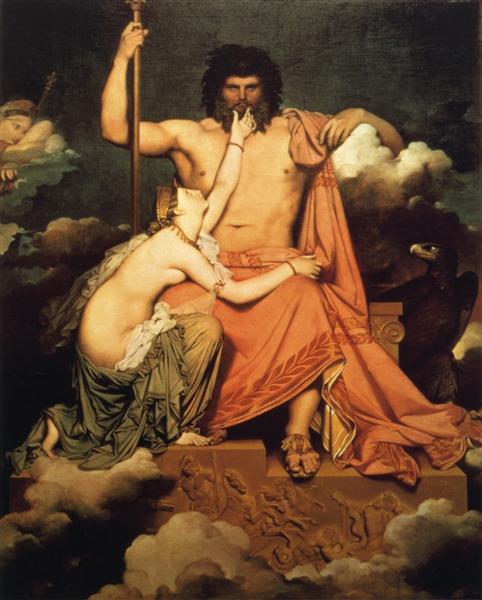“Zeus and Thetis” by Ingres – “thesis”, summarizing the internship in Rome, where he was sent by the Paris Academy of Fine Arts. He strove to make the picture as gracious and “pleasing to God” as possible, explaining that “it should exude the smell of ambrosia a mile away.” Ingres sent the final “parcel” (this is the name of his work, sent from Rome to Paris as part of an internship) to the Salon. The verdict was ruthless: the face of Zeus was called not noble enough, there were also enough reproaches for Thetis’ physique.
The painting is based on a mythological plot. The sea nymph Thetis attracted both Zeus and Poseidon. But the prediction said that the son she had born would surpass his father in strength. The gods decided to refrain from possible filial competition and gave Thetis in marriage to the mortal Peleus. From this marriage Achilles was born. The painting depicts Thetis, who came to Zeus and begged to protect her son in the confrontation with Agamemnon in the Trojan War. Thetis bent down at the knees of the supreme god, clasping them with one hand, the other stretched up and touches his beard.
The throne of Zeus hangs in the clouds, the figures of Zeus and Thetis are in sharp contrast. The figure of Zeus is dark, powerful, as if merged with a throne, with his left hand he rests on cumulus clouds. His gaze is directed into the distance, it seems that he does not even hear Thetis. Her figure all consists of smooth lines. Even what Ingres reproached – the unnaturally extended left arm of Thetis, her head thrown back too far and the neck that seemed too full for this reason – fulfills its function. The hand is like the embodiment of supplication and secret tenderness, and the whole figure as a whole, including the strange bend of the neck, embodies unbridled aspiration, as if this diagonal, in which Thetis is located in relation to Zeus, included all her aspirations, her whole life.
To the right of Zeus is an eagle, one of the attributes of God. On the left we see the figure of Hera, the wife of the Thunderer, lying on a cloud and watching what is happening. As you know, she was a very jealous goddess … But here her gaze is calm – she knows that Zeus does not heed the pleas of Thetis. But the intimate detail that we see is hidden from Hera. The touching toes of Zeus and Thetis bring a very warm, deeply lyrical and erotic note to the mood of the picture.
Year of painting: 1811.
Dimensions of the painting: 327 x 260 cm.
Material: canvas.
Writing technique: oil.
Genre: mythological painting.
Style: neoclassicism.
Gallery: Granet Museum, Aix-en-Provence, France.
